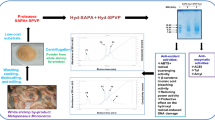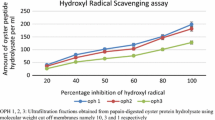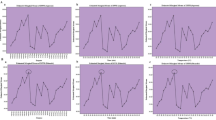Abstract
Purpose
Diplodus annularis is an underutilized protein-rich fish resource which is sold at a low cost. In this work, the valorization of Diplodus proteins as a source of bioactive protein hydrolysates is proposed.
Methods
Hydrolysates from Diplodus proteins were prepared using alcalase and savinase enzymes at optimal conditions and their antioxidant and antibacterial activities were evaluated. The hydrolysate that revealed the highest biological properties was fractionated by RP-HPLC and peptide fractions implied in bioactivity were determined using a peptidomic approach.
Results
The antioxidant properties of the hydrolysates were evaluated using various in vitro assays. The hydrolysate generated by savinase (DPH-S) generally exhibited a greater antioxidant activity across all the considered methods, in terms of ferrous chelating activity (\({IC}_{50}\)=2.19 mg mL−1), 1,1-diphenyl-2-picrylhydrazyl (DPPH) radical scavenging ability (\({IC}_{50}\)=3.76 mg mL−1) and reducing power activity (1.92 ± 0.12). Moreover, the alcalase-generated hydrolysate (DPH-AL) exhibited the highest β-carotene bleaching inhibitory effect (\({IC}_{50}\)=4.41 mg mL−1). The antibacterial activities of hydrolysates were also assessed. DPH-S exhibited the most important inhibitory effects against five strains of bacteria. It was chosen to undergo fractionation and purification by reverse phase-high performance liquid chromatography (RP-HPLC) into ten fractions and then identified by peptidomics approach. F4 which contained 408 peptides with molecular mass lower than 3000 Da, displayed the highest antioxidant activites and had significantly the highest percentage of bacteria inhibition against bacterial species (p < 0.05).
Conclusion
Our results revealed that DPH-S and its peptide fractions could be a new potential source for preparing natural antioxidants and antibacterials applied in food, pharmaceutical and cosmetic preparations.
Graphical Abstract










Similar content being viewed by others
Data Availability
The mass spectrometry proteomics data have been deposited with the ProteomeXchange Consortium via the PRIDE (Perez-Riverol et al., 2019) partner repository with the dataset identifier PXD041672. (Reviewer account details: Username: reviewer_pxd041672@ebi.ac.uk, Password: QLN5ONea).
References
Gao, R., Yu, Q., Shen, Y., Chu, Q., Chen, G., Fen, S., Sun, Q.: Production, bioactive properties, and potential applications of fish protein hydrolysates: developments and challenges. Trends Food Sci. Technol. 110, 687–699 (2021). https://doi.org/10.1016/j.tifs.2021.02.031
Sila, A., Bougatef, A.: Antioxidant peptides from marine by-products: isolation, identification and application in food systems: a review. J. Funct. Foods. 21, 10–26 (2016)
Centenaro, G. S., Centenaro, M. S., Prentice-Hernández, C.: Antioxidant activity of protein hydrolysates of fish and chicken bones. J. Food Sci. Technol (2011)
Bkhairia, I., Ben Slama Ben Salem, R., Nasri, R., Jridi, M., Ghorbel, S., Nasri, M.: In-vitro antioxidant and functional properties of protein hydrolysates from golden grey mullet prepared by commercial, microbial and visceral proteases. J. Food Sci. Technol. (2016). https://doi.org/10.1007/s13197-016-2200-5
Bougatef, H., Krichen, F., Kobbi, S., Martinez-Alvarez, O., Nedjar, N., Bougatef, A., Sila, A.: Physicochemical and biological properties of eel by-products protein hydrolysates: potential application to meat product preservation. Waste Biomass Valoriz. (2020). https://doi.org/10.1007/s12649-018-0424-5
Noman, A., Wang, Y., Zhang, C., Abed, S.M.: Antioxidant activity of hybrid sturgeon (Huso dauricus × Acipenser schrenckii) protein hydrolysate prepared using bromelain, Its fractions and purified peptides. J. Food. Nutr. Sci. (2022). https://doi.org/10.31883/pjfns/146317
Ktari, N., Ben Slama-Ben Salem, R., Bkhairia, I., Ben Slima, S., Nasri, R., Ben Salah, R., Nasri, M.: Functional properties and biological activities of peptides from zebra blenny protein hydrolysates fractionated using ultrafiltration. Food Biosci. (2020). https://doi.org/10.1016/j.fbio.2020.100539
Latorres, J.M., Rios, D.G., Saggiomo, G., Wasielesky, W., Prentice-Hernandez, C.: Functional and antioxidant properties of protein hydrolysates obtained from white shrimp (Litopenaeus vannamei). J. Food Sci. Technol. (2018). https://doi.org/10.1007/s13197-017-2983-z
Lassoued, I., Elgaoud, I., Hamed, F., Barkia, A.: Thornback ray gelatin hydrolysate as an alternative preservative: effect of hydrolysis degree. Alg. J. Nutr. Food Sci. 2(2), 9–14 (2022)
Famuwagun, A.A., Alashi, A.M., Gbadamosi, S.O., Taiwo, K.A., Oyedele, D.J., Adobooye, O., Aluko, R.E.: In vitro characterization of fluted pumpkin leaf protein hydrolysates and ultrafiltration of peptide fractions: antioxidant and enzyme-inhibitory properties. Polish J. Food Nutr. Sci (2020). https://doi.org/10.31883/pjfns/130401
Najafian, L., Babji, A.S.: A review of fish-derived antioxidant and antimicrobial peptides: their production, assessment, and applications. Peptides 33, 178–185 (2012)
Tang, W., Zhang, H., Wang, L., Qian, H., Qi, X.: Targeted separation of antibacterial peptide from protein hydrolysate of anchovy cooking wastewater by equilibrium dialysis. Food Chem. (2015). https://doi.org/10.1016/j.foodchem.2014.07.027
Abidi, F., Aissaoui, N., Gaudin, J.-C., Chobert, J.-M., Haertlé, T., Marzouki, M.N.: MS analysis and molecular characterization of Botrytis cinerea protease Prot-2. Use in bioactive peptides production. Appl. Biochem. Biotechnol. (2013). https://doi.org/10.1007/s12010-013-0186-2
Hamed, F., Elgaoud, I., Deracinois, B., Flahaut, C., Nedjar, N., Barkia, A.: Production of hydrolysates and peptides from a new protein source: Diplodus annularis. Food Biosci. (2022). https://doi.org/10.1016/j.fbio.2022.102129
Bersuder, P., Hole, M., Smith, G.: Antioxidants from a heated histidine-glucose model. J. Agric. Food Chem. 38, 674–677 (1998)
Koleva, I.I., Van Beek, T.A., Linssen, J.P.H., Groot, A.D., Evstatieva, L.N.: Screening of plant extracts for antioxidant activity: a comparative study on three testing methods. Phytochem. Anal. 13(1), 8–17 (2002)
Yildirim, A., Mavi, A., Kara, A.A.: Determination of antioxidant and antimicrobial activities of Rumex crispus L. extracts. J. Agric. Food Chem. 49(4083), 4089 (2001)
Decker, E.A., Welch, B.: Role of ferritin as a lipid oxidation catalyst in muscle food. J. Agric. Food Chem. 38(3), 674–677 (1990)
Prieto, P., Pineda, M., Aguilar, M.: Spectrophotometric quantitation of antioxidant capacity through the formation of a phosphomolybdenum complex: specific application to the determination of vitamin E. Anal. Biochem. (1999). https://doi.org/10.1006/abio.1999.4019
Berghe, V.A., Vlietinck, A.J.: Screening methods for antibacterial and antiviral agents from higher plants. Meth. Plant Biochem. 6, 47–68 (1991)
Perez-Riverol, Y., Bai, J., Bandla, C., Hewapathirana, S., García-Seisdedos, D., Kamatchinathan, S., Kundu, D., Prakash, A., Frericks-Zipper, A., Eisenacher, M., Walzer, M., Wang, S., Brazma, A., Vizcaíno, J.A.: The PRIDE database resources in 2022: a hub for mass spectrometry-based proteomics evidences. Nucleic Acids Res. 50(1), 543–552 (2022)
Nasri, R., Jridi, M., Lassoued, I., Jemil, I., BenSlamaBenSalem, R., Nasri, M., Karra-Châabouni, M.: The influence of the extent of enzymatic hydrolysis on antioxidative properties and ACE-Inhibitory activities of protein hydrolysates from Goby (Zosterisessor ophiocephalus) muscle. Appl. Biochem. Biotechnol. (2014). https://doi.org/10.1007/s12010-014-0905-3
Lassoued, I., Mora, L., Nasri, R., Aydi, M., Toldrá, F., Aristoy, M.-C., Barkia, A., Nasri, M.: Characterization, antioxidative and ACE inhibitory properties of hydrolysates obtained from thornback ray ( Raja clavata) muscle. J. Proteomics (2015). https://doi.org/10.1016/j.jprot.2015.05.007
De Quadros, C.D.C., Lima, K.O., Bueno, C.H.L., Fogaça, F.H.D.S., Da Rocha, M., Prentice, C.: Evaluation of the antioxidant and antimicrobial activity of protein hydrolysates and peptide fractions derived from Colossoma macropomum and their effect on ground beef lipid oxidation. J. Aquat. Food Prod. Technol. (2019). https://doi.org/10.1080/10498850.2019.1628152
Taktak, W., Nasri, R., López-Rubio, A., Hamdi, M., Gómez-Mascaraque, L.G., Nasri, M., Karra-Chaâbouni, M.: Enzymatic production of novel European Eel proteins hydrolysates: biological activities, techno-functional properties and maltodextrin-hydrolysates efficient electrosprayability. Int. J. Pept. Res. Ther. (2021). https://doi.org/10.1007/s10989-020-10156-x
Ahn, C.-B., Kim, J.-G., Je, J.-Y.: Purification and antioxidant properties of octapeptide from salmon byproduct protein hydrolysate by gastrointestinal digestion. Food Chem. (2014). https://doi.org/10.1016/j.foodchem.2013.09.136
Zarei, M., Ebrahimpour, A., Abdul-Hamid, A., Anwar, F., Bakar, F.A., Philip, R., Saari, N.: Identification and characterization of papain-generated antioxidant peptides from palm kernel cake proteins. Food Res. Int. (2014). https://doi.org/10.1016/j.foodres.2014.04.041
Pan, X.-Y., Wang, Y.-M., Li, L., Chi, C.-F., Wang, B.: Four Antioxidant peptides from protein hydrolysate of red stingray (Dasyatis akajei) cartilages: isolation, identification, and in vitro activity evaluation. Mar. Drugs (2019). https://doi.org/10.3390/md17050263
Chen, H.J., Dai, F.J., Chen, C.Y., Fan, S.L., Zheng, J.H., Chau, C.F., Lin, Y.S., Chen, C.S.: Effects of molecular weight fraction on antioxidation capacity of rice protein hydrolysates. Sci. Rep. (2023). https://doi.org/10.1038/s41598-022-14314-7
Guo, L., Hou, H., Li, B., Zhang, Z., Wang, S., Zhao, X.: Preparation, isolation and identification of iron-chelating peptides derived from Alaska pollock skin. Process Biochem. (2013). https://doi.org/10.1016/j.procbio.2013.04.013
Chalamaiah, M., Jyothirmayi, T., Diwan, P.V., Dinesh Kumar, B.: Antioxidant activity and functional properties of enzymatic protein hydrolysates from common carp (Cyprinus carpio) roe (egg). J. Food Sci. Technol. (2015). https://doi.org/10.1007/s13197-015-1714-6
Chunkao, S., Youravong, W., Yupanqui, C.T., Alashi, A.M., Aluko, R.E.: Structure and function of Mung bean protein-derived iron-binding antioxidant peptides. Foods (2020). https://doi.org/10.3390/foods9101406
Cruz-Huerta, E., Maqueda, D.M., De La Hoz, L., Nunes Da Silva, V.S., Pacheco, M.T.B., Amigo, L., Recio, I.: Short communication: Identification of iron-binding peptides from whey protein hydrolysates using iron (III)-immobilized metal ion affinity chromatographyand reversed phase-HPLC-tandem mass spectrometry. J. Dairy Sci. (2016). https://doi.org/10.3168/jds.2015-9839
Fan, C., Wang, X., Song, X., Sun, R., Liu, R., Sui, W., Jin, Y., Wu, T., Zhang, M.: Identification of a novel walnut iron chelating peptide with potential high antioxidant activity and analysis of its possible binding sites. Foods (2023). https://doi.org/10.3390/foods12010226
Miao, J., Liao, W., Pan, Z., Wang, Q., Duan, S., Xiao, S., Yang, Z., Cao, Y.: Isolation and identification of iron-chelating peptides from casein hydrolysates. Food Funct. (2019). https://doi.org/10.1039/C8FO02414F
Xia, Y., Bamdad, F., Gänzle, M., Chen, L.: Fractionation and characterization of antioxidant peptides derived from barley glutelin by enzymatic hydrolysis. Food Chem. (2012). https://doi.org/10.1016/j.foodchem.2012.03.063
Klompong, V., Benjakul, S., Kantachote, D., Shahidi, F.: Antioxidative activity and functional properties of protein hydrolysate of yellow stripe trevally (Selaroides leptolepis) as influenced by the degree of hydrolysis and enzyme type. Food Chem. (2007). https://doi.org/10.1016/j.foodchem.2006.07.016
Ben Slama-Ben Salem, R., Bkhairia, I., Abdelhedi, O., Nasri, M.: Octopus vulgaris protein hydrolysates: characterization, antioxidant and functional properties. J. Food Sci. Technol. (2017). https://doi.org/10.1007/s13197-017-2567-y
Sila, A., Haddar, A., Martinez-Alvarez, O., Bougatef, A.: Angiotensin-I-converting enzyme inhibitory and antioxidant activities of protein hydrolysate from muscle of barbel ( Barbus callensis ). J. Chem. (2013). https://doi.org/10.1155/2013/545303
Lassoued, I., Elgaoud, I., Hamed, F., Nasri, N., Nasri, M., Barkia, A.: Evaluation of four fish protein hydrolysates as a source of antioxidants and amino acids. Curr. Top. Pep. Protein Res. 22, 131–144 (2021)
Ajibola, C.F., Fashakin, J.B., Fagbemi, T.N., Aluko, R.E.: Effect of peptide size on antioxidant properties of african yam bean seed (Sphenostylis stenocarpa) protein hydrolysate fractions. Int. J. Mol. Sci. (2011). https://doi.org/10.3390/ijms12106685
Centenaro, G.S., Salas-Mellado, M., Pires, C., Batista, I., Nunes, M.L., Prentice, C.: Fractionation of protein hydrolysates of fish and chicken using membrane ultrafiltration: investigation of antioxidant activity. Appl. Biochem. Biotechnol. (2014). https://doi.org/10.1007/s12010-014-0732-6
Qian, Z.-J., Jung, W.-K., Kim, S.-K.: Free radical scavenging activity of a novel antioxidative peptide purified from hydrolysate of bullfrog skin. Rana catesbeiana Shaw. Bioresour. Technol (2008). https://doi.org/10.1016/j.biortech.2007.04.005
Elgaoud, I., Hamed, F., Lassoued, I., Chamkha, M., Oulahal, N., Degraeve, P., Adt, I., Barkia, A.: Production of hydrolysates from swordfish (Xiphias gladius) head muscle as new protein source: evaluation of nutritional, antioxidant and functional properties. Waste biomass valorization. (2023). https://doi.org/10.1007/s12649-023-02224-2
Lassoued, I., Mora, L., Nasri, R., Aydi, M., Toldrá, F., Aristoy, M.-C., Nasri, M.: Characterization, antioxidative and ACE inhibitory properties of hydrolysates obtained from thornback ray (Raja clavata) muscle. J. Proteom. 128, 458–468 (2015). https://doi.org/10.1016/j.jprot.2015.05.007
Atef, M., Chait, Y.A., Ojagh, S.M., Latifi, A.M., Esmaeili, M., Hammami, R., Udenigwe, C.C.: Anti-salmonella activity and peptidomic profiling of peptide fractions produced from sturgeon fish skin collagen (Huso huso) using commercial enzymes. Nutrients (2021). https://doi.org/10.3390/nu13082657
Da Rocha, M., Alemán, A., Baccan, G.C., López-Caballero, M.E., Gómez-Guillén, C., Montero, P., Prentice, C.: Anti-inflammatory, antioxidant, and antimicrobial effects of underutilized fish protein hydrolysate. J. Aquat. Food Prod. Technol. (2018). https://doi.org/10.1080/10498850.2018.1461160
Pezeshk, S., Ojagh, S.M., Rezaei, M., Shabanpour, B.: Fractionation of protein hydrolysates of fish waste using membrane ultrafiltration: investigation of antibacterial and antioxidant activities. Probiotics. Antimicrob Proteins (2019). https://doi.org/10.1007/s12602-018-9483-y
Sağdiç, O.: Sensitivity of four pathogenic bacteria to Turkish thyme and oregano hydrosols. Lebensm. Wiss. Technol. 36, 467–473 (2003)
Zasloff, M.: Antimicrobial peptides of multicellular organisms. Nature 415, 389–395 (2002)
Wald, M., Schwarz, K., Rehbein, H., Bußmann, B., Beermann, C.: Detection of antibacterial activity of an enzymatic hydrolysate generated by processing rainbow trout by-products with trout pepsin. Food Chem. (2016). https://doi.org/10.1016/j.foodchem.2016.03.002
Halpin-Dohnalek, M.I., Marth, E.H.: Staphylococcus aureus: Production of extracellular compounds and behavior in foods-A review. J. Food Prot. 52, 267–282 (1989)
Crum-Cianflone, N.F.: Salmonellosis and the gastrointestinal tract: more than just peanut butter. Curr. Gastroenterol. Rep. 10, 424–431 (2008)
Li, X.-R., Chi, C.-F., Li, L., Wang, B.: Purification and identification of antioxidant peptides from protein hydrolysate of scalloped hammerhead (Sphyrna lewini) cartilage. Mar. Drugs (2017). https://doi.org/10.3390/md15030061
Wongsrangsap, N., Chukiatsiri, S.: Purification and identification of novel antioxidant peptides from enzymatically hydrolysed Samia ricini Pupae. Molecules (2021). https://doi.org/10.3390/molecules26092588
Bhandari, D., Rafiq, S., Gat, Y., Gat, P., Waghmare, R., Kumar, V.: A review on bioactive peptides: physiological functions, bioavailability and safety. Int. J. Pept. Res. Ther. 26, 139–150 (2020)
Zhang, Y., Wang, J., Zhu, Z., Li, X., Sun, S., Wang, W., Sadiq, F.A.: Identification and characterization of two novel antioxidant peptides from silkworm pupae protein hydrolysates. Eur. Food Res. Technol. (2021). https://doi.org/10.1007/s00217-020-03626-5
Powers, J.-P.S., Hancock, R.E.W.: The relationship between peptide structure and antibacterial activity. Peptides (2003). https://doi.org/10.1016/j.peptides.2003.08.023
Sila, A., Nedjar-Arroume, N., Hedhili, K., Chataigné, G., Balti, R., Nasri, M.: Antibacterial peptides from barbel muscle protein hydrolysates: activity against some pathogenic bacteria. LWT-Food Sci. Technol. 55, 183–188 (2014)
Dong, N., Ma, Q., Shan, A., Lv, Y., Hu, W., Gu, Y., Li, Y.: Strand length-dependent antimicrobial activity and membrane-active mechanism of arginine- and valine-rich β-hairpin-like antimicrobial peptides. Antimicrob. Agents Chemother. (2012). https://doi.org/10.1128/AAC.06327-11
Funding
This research was funded by the Alibiotech research program, which is financed by European Union, France, and the French region Hauts-de-France. The HPLC–MS/MS experiments were performed on the REALCAT platform funded by a French governmental subsidy managed by the French National Research Agency (ANR) within the framework of the “Future Investments” program (ANR-11- EQPX-0037)”. The Hauts-de-France region and the FEDER, the Ecole Centrale de Lille, and the Centrale Initiatives Foundation are also warmly acknowledged for their financial contributions to the acquisition of REALCAT platform equipment.
Author information
Authors and Affiliations
Contributions
Conceptualization, methodology, BD, CF, FH, IE, SE, validation, BD, AB, NN; formal analysis, FH, BD, AB, NN; investigation, BD, FH; resources, CF; data curation, BD, AB, NN; writing—original draft preparation, FH, BD, CF, AB, NN; writing—review and editing, FH, BD, CF, NN, AB; visualization, BD, CF, AB, NN; supervision, project administration, funding acquisition, All authors have read and agreed to the published version of the manu-script.
Corresponding authors
Ethics declarations
Competing interest
The authors have not disclosed any competing interests.
Additional information
Publisher's Note
Springer Nature remains neutral with regard to jurisdictional claims in published maps and institutional affiliations.
Rights and permissions
Springer Nature or its licensor (e.g. a society or other partner) holds exclusive rights to this article under a publishing agreement with the author(s) or other rightsholder(s); author self-archiving of the accepted manuscript version of this article is solely governed by the terms of such publishing agreement and applicable law.
About this article
Cite this article
Hamed, F., Elgaoud, I., Eljoudi, S. et al. Diplodus Protein Hydrolysates: Antioxidant and Antibacterial Properties and Identification of Biopeptides. Waste Biomass Valor (2024). https://doi.org/10.1007/s12649-023-02403-1
Received:
Accepted:
Published:
DOI: https://doi.org/10.1007/s12649-023-02403-1




